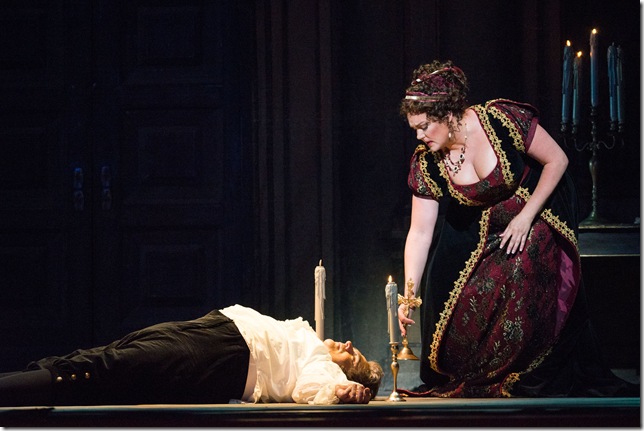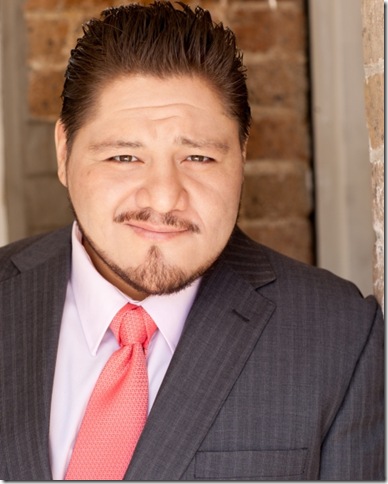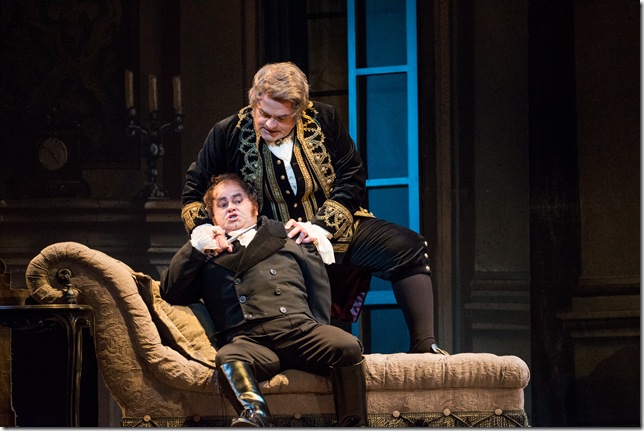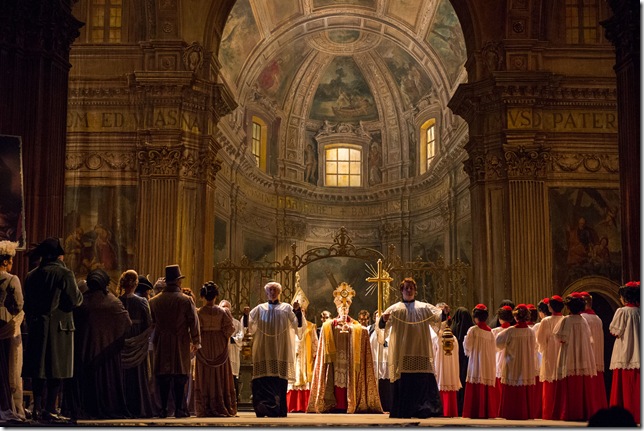Giacomo Puccini’s Tosca is, with the exception of the one-act Il Tabarro, the most veristic of the Italian composer’s works, and it needs a lot of good red blood to make it work.
I don’t mean literal blood, of course, though there could have been some in several spots in the opera Saturday night at the Broward Center for the Performing Arts, but the figurative kind: A thorough, passionate engagement on the part of its cast and musicians.
Fortunately, this Tosca, the third of Florida Grand Opera’s current productions, had all that, and the result was a highly successful evening of theater that was loudly acclaimed by a large house on closing night.
Puccini’s opera, which debuted in the second week of the 20th century (Jan. 14, 1900), has always been popular, and its simple melodrama fits right in with the mass taste that has been the mainstream since movies and then television were in their infancy. Despite its setting in 1800 and its slight dusting of Napoleonic politics, it’s not a plot that poses any problem at all for a 21st-century audience.
The central characters in this opera are carefully characterized in Puccini’s abundantly melodic music, and what’s required is that the voices be good enough to bring that all out.
Soprano Kara Shay Thomson made an excellent Tosca, boasting a very large, powerful voice with a thrilling top that bloomed in its highest registers rather than sound strained or oversung. Her Vissi d’arte in Act II was very slow, which stopped the action dead (as this aria almost always does), but the compensation was being able to hear Thomson’s voice in all its considerable richness and strength.
She was somewhat stiff as an actress, and in this aria she stood virtually still until the final bars; director Jose Maria Condemi probably meant to make the moment seem like an epiphany, but it also presented lost opportunities for the text, which indicates something more frantic.
In the duets with Diego Torre, the young Mexican tenor who sang Cavaradossi on Saturday night, she seemed to draw even more vocal strength from their partnership, especially in the Act I duets, when her voice soared into the heights with ease along with his. Torre, who was the second-cast tenor, also has quite a large, commanding voice, exciting throughout its range, and well-suited for emotional lyric tenor roles like this.
His Recondita armonia was very strong, but somewhat belty and not very subtle; all the notes were there, but it could have used some warmth. His E lucevan le stelle was more effective; the slow pace of this heartbreaking aria gave him an opportunity to give great attention to each phrase, and his E muoio disperato was potently believable. As mentioned, Torre and Thomson were ideal vocal partners, singing with unforced, massive breadth and ardor; their duets offered some of the best singing of the night.
Todd Thomas was a first-rate Scarpia, sweeping into the church of Act I with malevolence, and really coming into his own in Act II with Ha píu forte sapore, an aria often seen as indebted to Iago’s aria in Verdi’s Otello, and surely it is. But Thomas’s bronze instrument shone beautifully here, and he sang Scarpia’s creepy text with unalloyed joy, giving the audience a skin-crawling insight into the mind of a sadist.
The great Te Deum scene that ends Act I was little too fast for my taste, and lost a good deal of magnificence thereby, and for some reason Thomas and Jason Ferrante’s Spoletta sang their opening dialogue beginning Tre sbirri, una carrozza, almost inaudibly, which made very little sense. After that, though, the steel of Thomas’ voice could be heard clearly, even amid the usual balance problems of having to sing against a big orchestral buildup and a chorus of people reciting the prayer.
In the minor roles, the always dependable bass Adam Lau was a beautifully voiced Angelotti (and Sciarrone, too), and another Californian, bass Andrew Funk, was an excellent Sacristan. Ferrante has a pleasant tenor voice, and he was a cringing Spoletta, which added an interesting dimension to the opera. Even the jailer, Dennis Ryan, sang with authority and muscle.
Ramón Tebar led a magnificent assemblage of orchestral musicians who played this difficult and busy score with color and resource; only in the four-cello accompaniment to Cavaradossi’s final letter did the music slip somewhat from its lofty level with some insecure high Tebar conducted with his normal fire and energy, and with the exception of Vissi d’arte, has eliminated the overwrought fussiness that have marred some of his interpretations.
This was an utterly traditional Tosca, presented amid good sets from the Seattle Opera, and staged conservatively by Condemi. The Argentine director also made his Sciarrone a victim of Scarpia’s abuse rather than a co-conspirator, seeing him thrown to the ground when Sciarrone announces the victory of Napoleon. The supernumerary role of Roberti the torturer was overdone by Joe Elalouf, who never stopped leering and playing with his rope; it made that part of the scene a little cartoonish.
This was a mainstream Tosca without surprises, but it had often wonderful singing by two leads with dominating voices, and a villain acted and sung with great power and malice by a veteran performer. Coupled with a splendid orchestra, this was a Tosca in which musical considerations came first, and it turned out to be a most satisfying night of opera.
Florida Grand Opera’s final production is Jules Massenet’s Thaïs. The title character will be sung by Eglise Gutierrez on May 3, 6, 15 and 17, and by Angela Mortellaro on May 4 and 10. Kristopher Irmiter is Athanaël in a production from Opera St. Louis and the Opéra de Montréal directed by Renaud Doucet. Performances through May 10 are at the Ziff Ballet Opera House in Miami; the May 15 and 17 performances are at the Broward Center for the Performing Arts in Fort Lauderdale. For more information, call 800-741-1010 or visit www.fgo.org.



